浏览器缓存机制
缓存机制有很多,例如:浏览器缓存机制、服务器缓存机制、代理服务器缓存。。。
我们在这里主要说浏览器的缓存机制。
浏览器的缓存机制分为两种:
浏览器缓存机制主要是由响应头控制的。
强制缓存
通常浏览器的请求中包含disk cache或memory cache就表示有强制缓存了。
强制缓存只要服务器设置响应头就行,客户端不需要配合。
设置强制缓存的响应头包含:
- expires
- pragma
- cache-control
expires和pragma是在http1.1之前就已经存在的两个键。
cache-control是http1.1之后才有键,所以优先级比expires要高。
expires
expires主要用于设置缓存的时间,值是RFC 2822 格式的时间字符串,如果设置的值不是这样一个字符串或不是一个时间,则设置了也不会生效。
例:
1
2
3
4
5
6
7
8
9
10
11
12
13
14
15
16
17
18
19
20
21
22
23
24
25
26
27
28
29
30
|
function getRFC2822Date(addSeconds = 3) {
const RFC2822Format = "ddd, DD MMM YYYY HH:mm:ss [GMT]";
return moment()
.utc()
.add(addSeconds, 's')
.format(RFC2822Format)
}
console.log(getRFC2822Date());
app.get('/expires', (req, res) => {
console.log('请求来了')
app.set('etag', false)
res.setHeader(
'Expires',
getRFC2822Date()
)
res.send(`
<script>
function getData() { fetch('http://localhost:3000/expires')}
</script>
<div>
Expires!
<button onclick="getData()">re get</button>
</div>`
)
})
|
点击5次的效果:
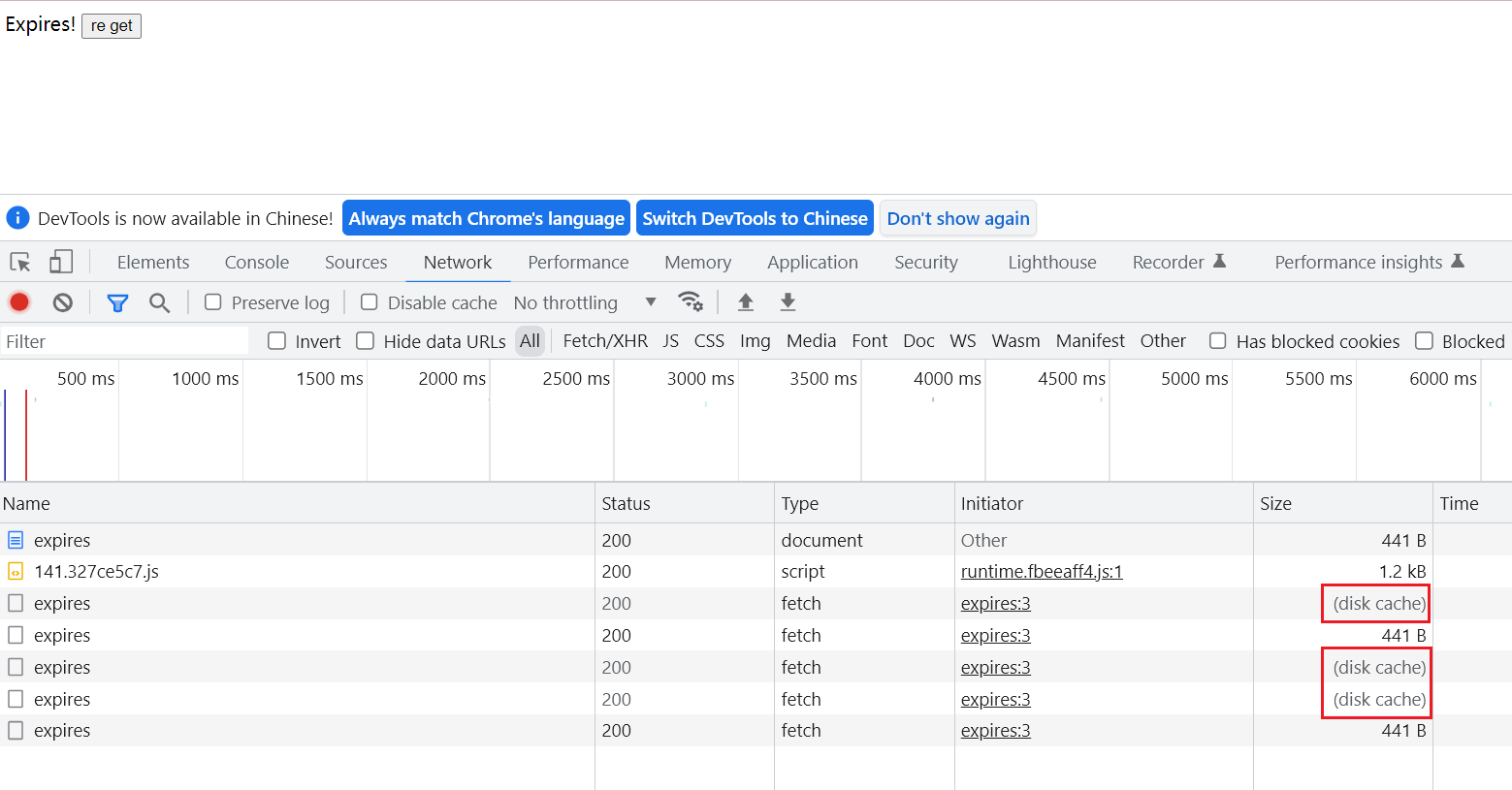

pragma
对应的值只有no-cache,是用来防止缓存的,只要设置了这个响应头就不会被缓存。
例:
1
2
3
4
5
6
7
8
9
10
11
12
13
14
15
16
17
18
19
20
21
22
23
24
25
| function getRFC2822Date(addSeconds = 10) {
const RFC2822Format = "ddd, DD MMM YYYY HH:mm:ss [GMT]";
return moment()
.utc()
.add(addSeconds, 's')
.format(RFC2822Format)
}
app.get('/pragma', (req, res) => {
app.set('etag', false)
res.setHeader(
'Expires',
getRFC2822Date()
)
res.setHeader('Pragma', 'no-cache')
res.send(`
<script>
function getData() { fetch('http://localhost:8800/pragma')}
</script>
<div>
Pragma!
<button onclick="getData()">re get</button>
</div>`
)
})
|
点击5次的效果:
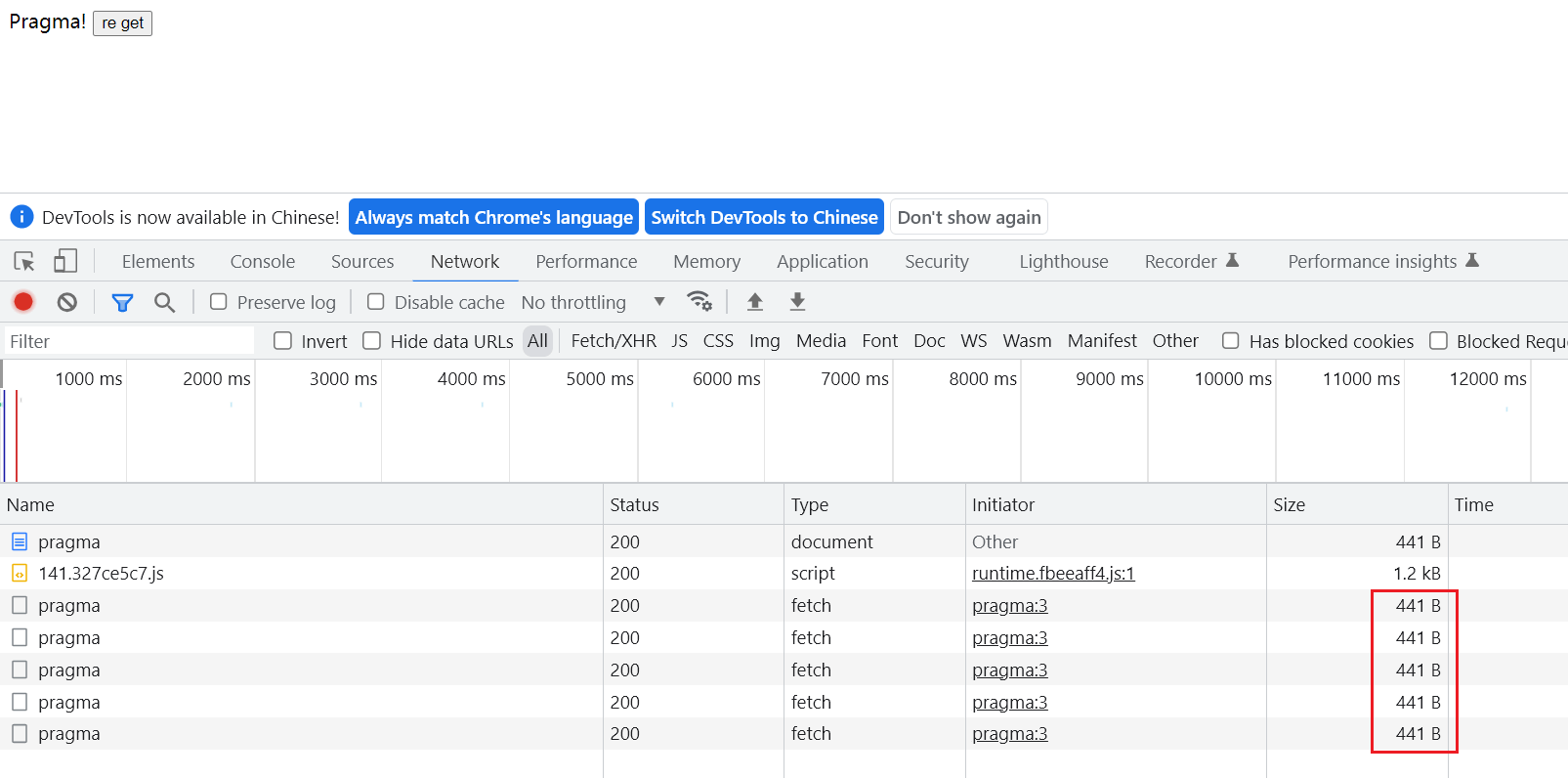

虽然设置了expires,但也不会被缓存,因为设置了Pragma,取消缓存了。
cache-control
跟expires也是用于设置缓存的,对应的值有很多,但我们通常使用的只有一个max-age,用于设置缓存有效期,单位秒。
- private:内容是对用户私有的,只能在浏览器端缓存,不能在其他地方(缓存除了浏览器可以缓存,还可以有代理服务器的缓存)缓存
- public:内容是公开的,可以在任何地方进行缓存,可以是浏览器,也可以是代理服务器
- no-store:内容不可以被任何地方缓存
- no-cache:表示内容可以被缓存,但是浏览器每次都需要请求服务器,对内容进行对比校验
- max-age:缓存内容的过期时间,单位是秒,使用起来比exprires更加友好。
- s-max-age:作用是一样的,但是这个值通常代表代理服务器上的时间,如果浏览器中同时有这两个属性, 浏览器有限使用max-age
- must-revalidate:在某些情况下,服务器无法访问,浏览器会使用缓存的内容,哪怕这个缓存的有效期已经超过了max-age,超过后必须去请求服务器。
- proxy-revalidate:作用跟muse-revalidate一样。针对代理服务器。
例:
1
2
3
4
5
6
7
8
9
10
11
12
13
14
| app.get('/cacheControl', (req, res) => {
console.log('请求来了');
res.set('cache-control', 'max-age=3')
res.send(`
<script>
function getData() { fetch('http://localhost:3000/cacheControl')}
</script>
<div>
Cache-Control max-age!
<button onclick="getData()">re get</button>
</div>`
)
})
|
点击5次的效果:
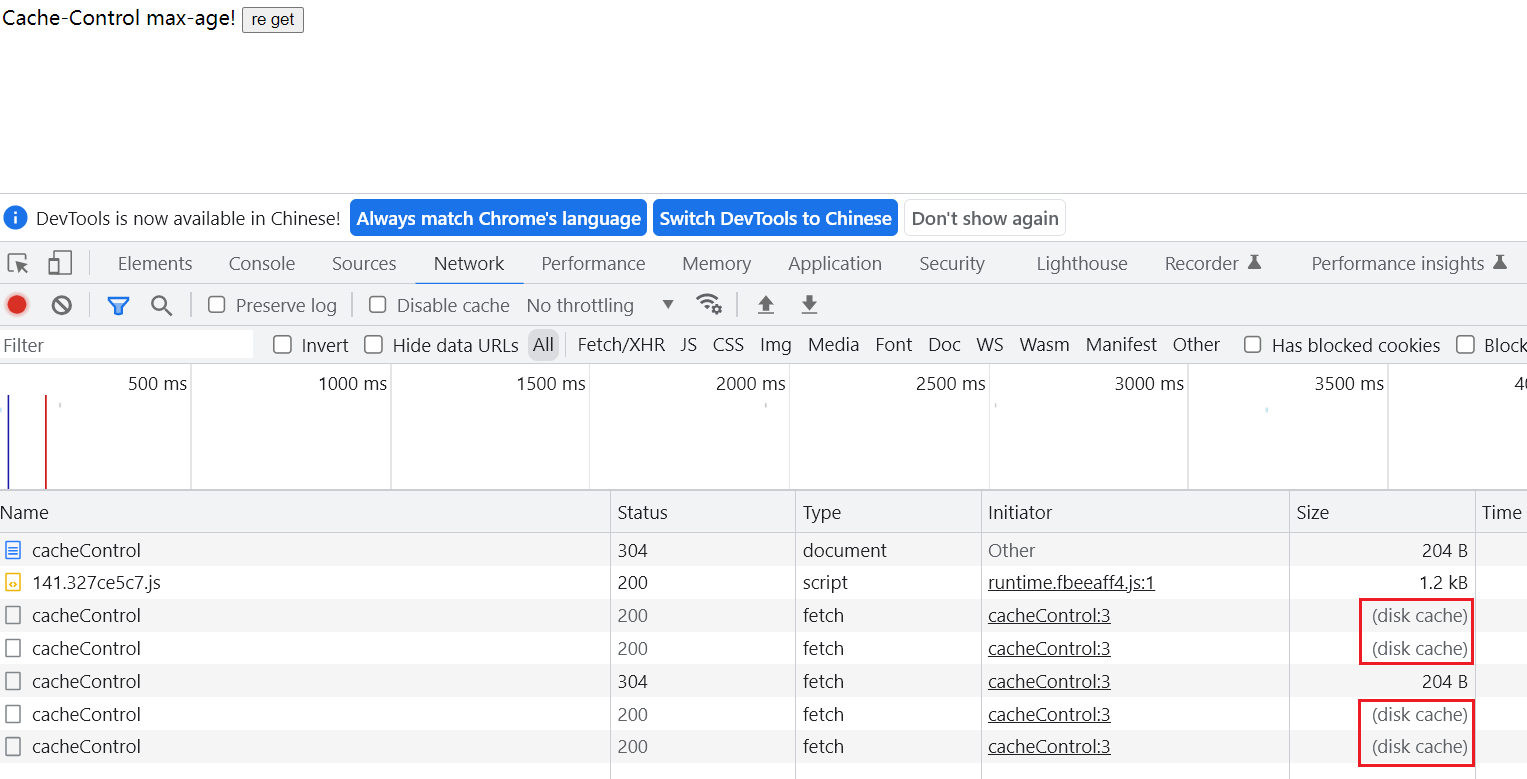

协商缓存
协商缓存是服务器设置缓存,但是需要客户端配合,不过配合是自动配合,也不需要手动去设置。
Last-Modified
服务器设置协商缓存的响应头是Last-Modified,值是一个时间戳。
具体过程:当服务器没有设置Last-Modified的时候,客户端也不会有If-Modified-Since;如果第一次请求服务器设置了Last-Modified响应头,第二次请求的时候,客户端会自动带上If-Modified-Since请求头,值是第一次服务器响应的Last-Modified的值。服务器接收到第二次请求的时候,先获取到If-Modified-Since的值,跟自己设置的Last-Modified的值进行对比,如果相等,说明,内容不需要进行更改,响应304状态码;如果不相等,说明内容需要更新,响应新内容。
例:
准备好被静态托管的静态资源:
1
2
3
4
5
6
7
8
9
10
11
12
13
14
15
16
17
18
| <body>
<button>按钮</button>
</body>
<script>
document.querySelector('button').onclick = function() {
var xhr = new XMLHttpRequest;
xhr.open('get','/lastModify');
xhr.send()
xhr.onreadystatechange = function(){
if(xhr.readyState === 4){
if(xhr.status>=200 && xhr.status<300){
var res = xhr.responseText;
console.log(res);
}
}
}
}
</script>
|
创建服务器,进行静态资源托管:
1
2
3
4
| const express = require('express')
const app = express()
app.listen(3000)
app.use(express.static('public'))
|
处理点击后发起的请求,并处理协商缓存:
1
2
3
4
5
6
7
8
9
10
11
| app.get('/lastModify', (req, res) => {
res.set('cache-control', 'no-cache')
let mtime = fs.statSync('./data.json').mtime
res.setHeader('Last-Modified', mtime.toGMTString())
if(req.headers['if-modified-since'] && req.headers['if-modified-since'] === mtime) {
res.status(304)
} else {
res.send(fs.readFileSync('./data.json'))
}
})
|
被读取的data.json文件:
第一次请求响应状态码是200,后续不许改data.json文件,响应状态码为304,直到修改data.json后响应状态码再变成200。
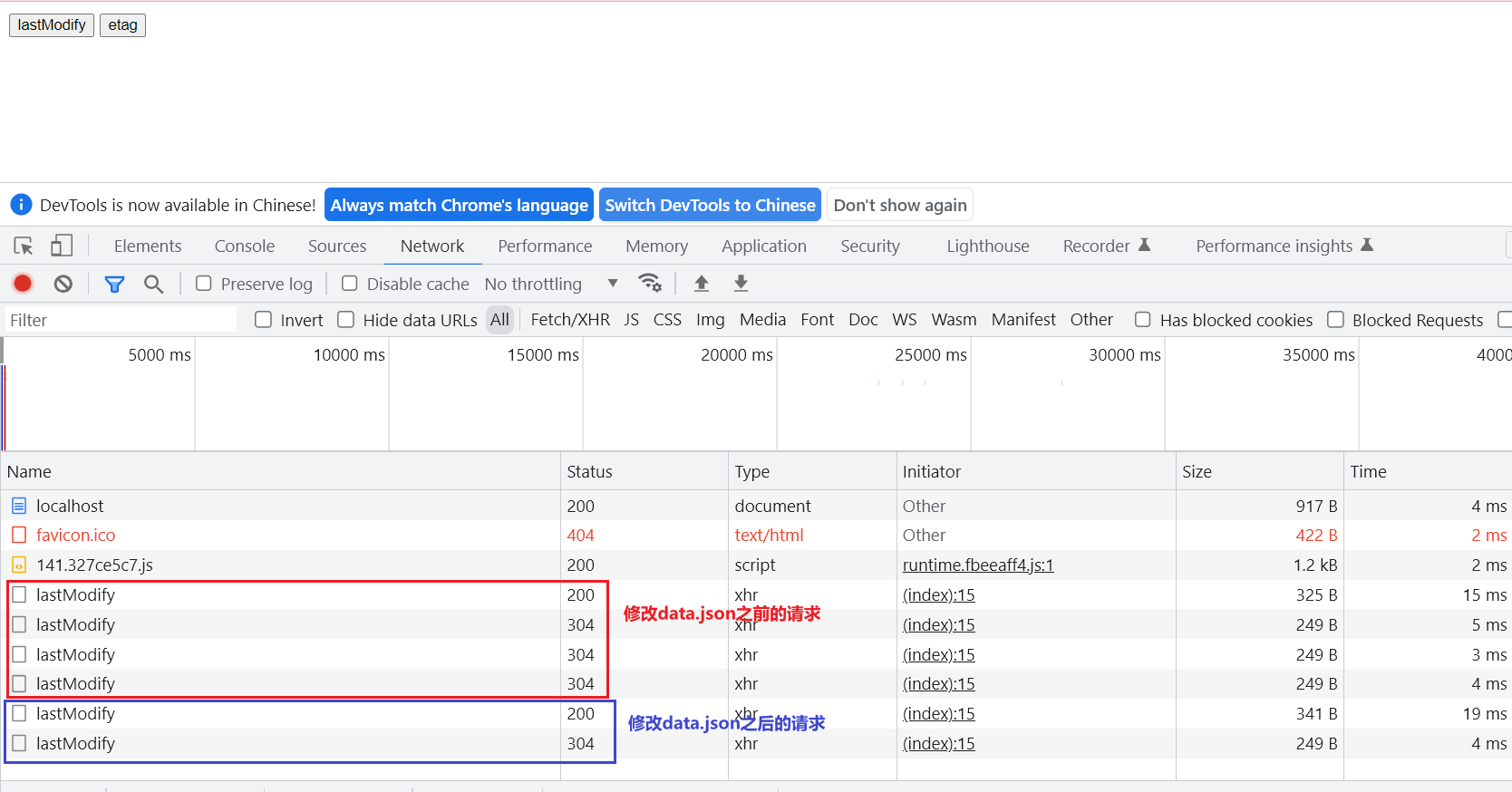
ETag
ETag也是服务器开启的协商缓存,优先级比Last-Modified高。
服务器只要开启了ETag,会在响应头中携带ETag响应头,下次请求的时候,客户端会自动携带If-None-Match请求头,服务器会自动对比是否一致,一致就返回304,不一致,就重新响应新内容,并响应200。
原理跟if-modified-since一样,只是自动了。
准备好被静态托管的静态资源:
1
2
3
4
5
6
7
8
9
10
11
12
13
14
15
16
17
18
| <body>
<button>按钮</button>
</body>
<script>
document.querySelector('button').onclick = function() {
var xhr = new XMLHttpRequest;
xhr.open('get','/etag');
xhr.send()
xhr.onreadystatechange = function(){
if(xhr.readyState === 4){
if(xhr.status>=200 && xhr.status<300){
var res = xhr.responseText;
console.log(res);
}
}
}
}
</script>
|
创建服务器,进行静态资源托管:
1
2
3
4
| const express = require('express')
const app = express()
app.listen(3000)
app.use(express.static('public'))
|
处理点击后发起的请求,并处理协商缓存:
1
2
3
4
| app.get('/etag', (req, res) => {
app.set('etag', true)
res.send('etag')
})
|
内容不变则一直是304,内容变了重新响应200。
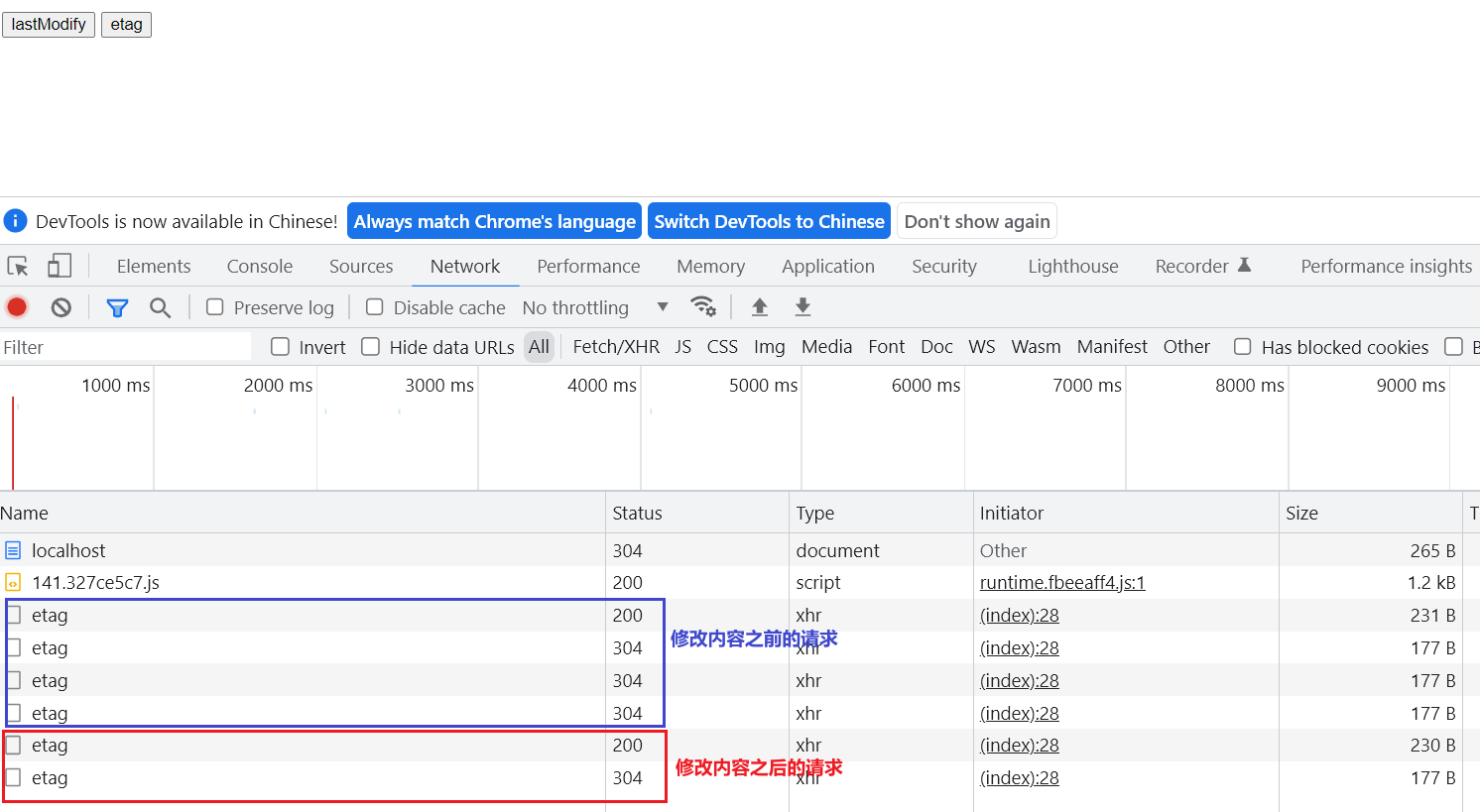
总结
缓存运行图:
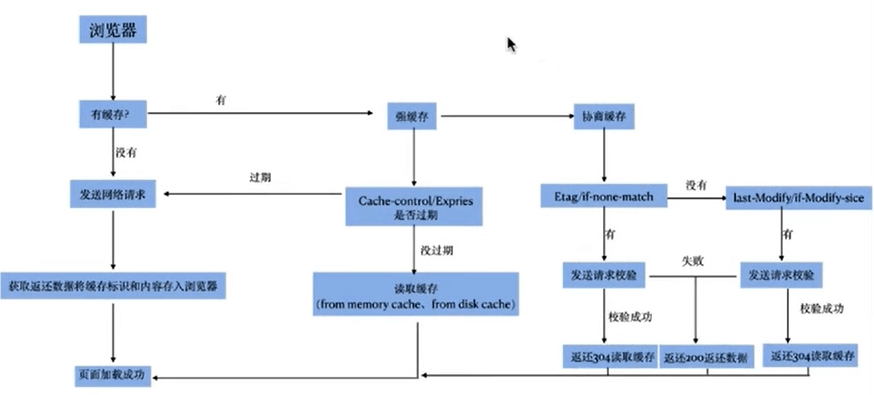
通常会将html设置为协商缓存,其他静态资源设置为强缓存。
f5刷新会暂时禁止强缓存,还会有协商缓存,ctrl+f5会禁止所有缓存策略。



















